Light: Reflection & Refraction - Class 10th Science
Introduction
Light travels in straight line. An opaque object obstructs rays of light when it comes in the path of light, and casts a shadow, this phenomenon tells that rays of light travels in straight line.
When rays of light fall on an object, they bounce back and come to our eyes. Bouncing back of light after falling on an object to our eyes enables us to see a particular object. We cannot see an object in dark, because there is no light present in dark which can be bounced back to our eyes.
Reflection of Light
Bouncing back of rays of light from an object is called REFLECTION OF LIGHT.
A highly polished surface reflects most of the light falling on it. For example a mirror, which has polished surface, reflects most of the light falling on it.
Incident Ray
Rays of light which falls on a reflecting surface is called Incident Ray.
Reflected Ray
Rays of light bouncing back from a reflecting surface is called Reflected Ray.
Normal
An imaginary line perpendicular to reflecting surface at the point of falling of ray of light is called NORMAL or normal to the Reflecting surface.
Angle of Incidence
Angle at which ray of light falls on a reflection surface to the normal is called ANGLE OF INCIDENCE.
Angle of Reflection
Angle at which ray of light bounces back from a reflecting surface to the normal is called ANGLE OF REFLECTION.
Laws of Reflection
(i) The angle of reflection of incidence is equal to the angle of reflection, and
(ii) The incident ray, the normal to the mirror, at the point of incidence and their reflected ray, all lie in the same plane.
Laws of Reflection are applied to all type of reflecting surfaces.
Types of Reflecting Surface
Reflecting surfaces may be plane, curved, spherical or uneven.
Spherical Mirrors
Spherical mirrors are of two types. One which reflecting surface is curved inwards and other with reflecting surface outwards.
Spherical mirrors having reflecting surface curved inwards are called CONCAVE MIRROR or CONCAVE SHPERICAL MIRROR.
Spherical mirrors having reflecting surface curved outwards are called CONVEX MIRROR or CONVEX SPHERICAL MIRROR.
Example: A spoon having reflecting surface inwards is similar to a concave mirror and having reflecting surface outwards is similar to a convex mirror.
Reflecting surface of a spherical mirror forms a part of sphere.
Important terms for Spherical Mirror
Pole
The centre of reflecting surface of a spherical mirror is called pole. Pole is denoted by letter 'P'.
Centre of Curvature
Since spherical mirror is a part of a sphere, thus centre of the sphere is called the centre of curvature of the spherical mirror.
Centre of curvature is not the part of spherical mirror and it lies outside of its reflecting surface.
The centre of curvature lies in front of a Concave mirror while centre of curvature lies behind the mirror.
Centre of curvature is conventionally denoted by letter 'C'.
Radius of Curvature
The radius of sphere of which spherical mirror is a part is called the Radius of Curvature of the spherical mirror.
Radius of curvature is also not the part of reflecting surface of the spherical mirror. Similar to Centre of Curvature, Radius of Curvature also lies outside of the spherical mirror.
In the case of concave mirror radius of curvature lies in front of spherical surface while in the case of convex mirror it lies behind the reflecting surface.
Radius of Curvature is denoted by letter 'R'.
Principal Axis
An imaginary line passes through the pole and centre of curvature of a spherical mirror is called PRINCIPAL AXIS.
The Principal Axis of a spherical mirror is normal to the mirror at its pole.
Focus
Rays coming from infinity are parallel to the principal axis and pass through a point of spherical mirror. This point is called FOCUS or PRINCIPAL FOCUS of a spherical mirror. Focus is known as Focal Point also.
Focus of a concave mirror lies in front of reflecting surface while in the case of convex mirror Focus lies behind the reflecting surface.
Focus or Principal Focus is denoted by letter 'F'.
Focal Length
The distance from Focus to Pole of a spherical mirror is called Focal Length. Focal length is denoted by letter 'f'.
Focal length is half of the radius of curvature.
Therefore, R = 2f
This means focal length of a spherical mirror lies midway between the pole and the centre of curvature.
Aperture
The diameter of the reflecting surface of a spherical mirror is called its APERTURE.
Spherical mirror can be of many sizes. Spherical mirror having big size has large aperture while spherical mirror having small size has small aperture.
Reflection of light through Spherical Mirror
Reflection of Ray of light coming from infinity from Concave Mirror
Rays of light coming from infinity travels parallel to principal axis. After reflecting through surface of concave mirror, it passes through principal focus of the mirror.
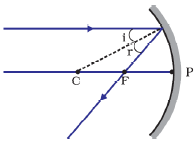
All rays of light coming through infinity travels parallel to principal axis and pass through principal focus after reflecting from concave mirror.
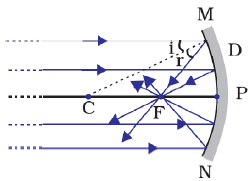
Here angle of incidence 'i' is equal to the angle of reflection 'r'. In this case DC is normal to the point of reflection.
Since, a Convex Mirror converge all rays coming from infinity to its principal focus, thus a Convex Mirror is known as Converging Mirror also.
Reflection of Ray of light coming from infinity from Convex Mirror
Ray of light coming from infinity travels parallel to principal axis and appears to passing through principal focus after reflection from a Convex Mirror.
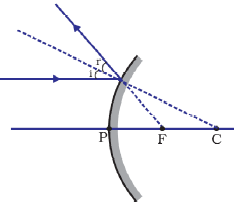
All rays coming from infinity travel parallel to principal axis and appear passing through the principal focus after reflecting from a convex mirror.
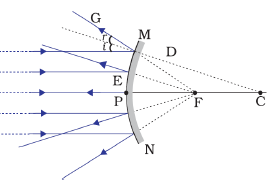
Since, all rays coming from infinity diverge after reflection from a Concave mirror, thus a Concave Mirror is known as Diverging Mirror also.
Reflection of ray of light directing through the Principal Focus from a Concave Mirror
A ray of light directing through the principal focus of a concave mirror passes towards parallel to the principal axis after reflection from a concave mirror.
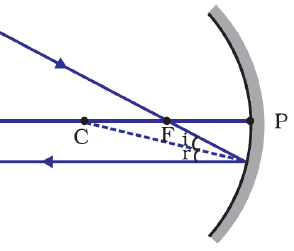
This is just opposite to the ray directing parallel to the principal axis.
Reflection of ray of light directing through the Principal Focus from a Convex Mirror
A ray of light directing through the principal Focus passes parallel to the principal axis after reflection from a Convex Mirror.
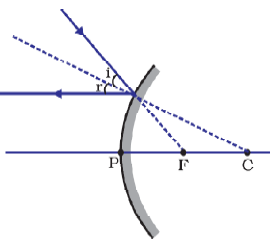
Reflection of ray passing through the centre of curvature of the Concave Mirror
Ray of light passing or directing through the centre of curvature redirects on the same path, i.e. from the centre of curvature in the same direction after reflection from a Concave Mirror.
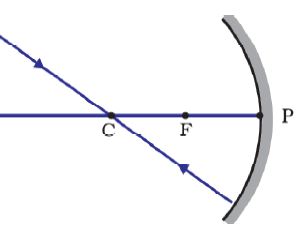
Reflection of ray passing through the centre of curvature of the Convex Mirror
Ray of light passing or directing through the centre of curvature redirects on the same path, i.e. from the centre of curvature in the same direction after reflection from a Convex Mirror.
Reflection of ray of light incident obliquely to the Principal axis towards a Pole of a Concave Mirror
A ray of light incident obliquely to the Principal axis towards pole, directs obliquely to the principal axis after reflection from a Concave Mirror at the same angle of incident.
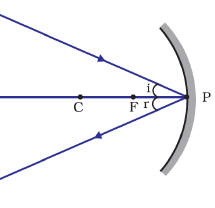
Reflection of ray of light incident obliquely to the Principal axis towards a Pole of a Convex Mirror
A ray of light incident obliquely to the Principal axis towards pole, directs obliquely to the principal axis after reflection from a Convex Mirror at the same angle of incident.
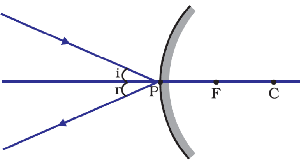
Since, reflection of light from any surface follows the Laws of Reflection, thus in all the cases, angle of incidence (i) to the normal is equal to the angle of reflection (r) to the normal.
Real Image: Image which can be cast on screen is called Real Image. Real image is formed always in front of mirror.
Virtual Image: Image which cannot be cast on screen is called Virtual or Imaginary Image. Virtual image is formed behind the mirror.
Images are taken from NCERT Book class 10 chapter: Light: Reflection and Refraction